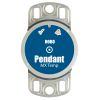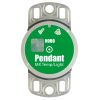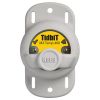HOBO Water Temp Pro v2 Logger
The Onset HOBO Water Temp Pro v2 logger is designed with a durable, streamlined, UV-stable case for extended deployments measuring temperature in fresh or salt water.
Features
- Research-grade measurements at an affordable price
- Waterproof up to 120 meters (400 feet)
- Compatible with HOBOware and HOBOware Pro software
- Expedited repair and warranty service
- Lifetime technical support
- More
Overview
Built to withstand extended periods of immersion, the compact HOBO Water Temp Pro v2 Logger provides reliable, accurate underwater temperature measurements. The small size of the logger allows it to be easily mounted and/or hidden in the field.
Durable
The HOBO Water Temp Pro v2 logger is waterproof up to 120 m (400 feet) and rugged enough to withstand years of use, even in stream conditions. It has enough memory to record over 42,000 12-bit temperature measurements.
Mechanics
The Water Temp Pro v2 Logger requires an infrared base station (90706) or shuttle (90707) and HOBOware, available as a free download, or HOBOware Pro software (sold separately) for system launch and data retrieval. The associated couplers are included with both the base station and shuttle. In addition, the shuttle can operate as a base station for added flexibility in the field.
Data Storage
The high-speed infrared communications offloads data in less than 30 seconds (requires USB port), and the infrared communications port is located opposite the bail end for convenient access while tethered. Offload data or check the logger and battery status, even while logging. A blinking LED indicates that the logger is recording data. To reduce visibility in the field, this feature can be turned off. Non-volatile EEPROM memory retains measurements in the event of battery failure.
In The News
Wildfire Prevention in the Sierra Nevada Region with the Yuba Watershed Institute
Though recent wildfires have sparked new conversations about wildfire management and response, groups like the Yuba Watershed Institute have been monitoring the forests and water resources of the Sierra Nevada region for decades, managing approximately 5,000 acres of land with the Bureau of Land Management (BLM) and about 7,000 acres in private land partnerships. The goal of the Institute is to work with local communities and land agencies to improve watershed and forestry management through informed practices and public outreach. The goals of the Yuba Watershed Institute are three-fold: Improve the ability of fire suppression agencies like the California Department of Forestry and Fire Protection ( CAL FIRE ) and the US Forest Service.
Read MoreWave Sensors Integration with NexSens Buoys: A Cutting-Edge Solution for Wave Measurment
Real-time wave data supports accurate weather prediction, safe and efficient maritime operations, and provides valuable safety and operating condition information for recreation and commercial fishing. Understanding wave dynamics also helps with the design of protective coastal structures like seawalls, breakwaters, and jetties. It also supports better prediction of their impact on sediment transport and coastal geomorphology. Wave data is a key factor in qualifying and designing offshore wind farms and harnessing kinetic energy for electrical generation. It helps with the understanding of ocean-atmosphere interactions and contributes to studies of sea-level rise and climate change impacts.
Read MoreSpring 2025 Environmental Monitor Available Now
In the Spring 2025 edition of the Environmental Monitor, we highlight partnerships across the world and the importance of collaboration between government agencies, universities, environmental groups, local communities, and other stakeholders. From great white shark research in Cape Cod to monitoring fisheries in Lake Erie, this latest edition underscores partnerships that connect stakeholders in a watershed through environmental data. With an emphasis on data sharing, a combination of real-time and discrete sampling keeps the public and partners informed of environmental conditions. Our writers also sought out science professionals dedicated to working with peers within and outside of the environmental sector.
Read More


















